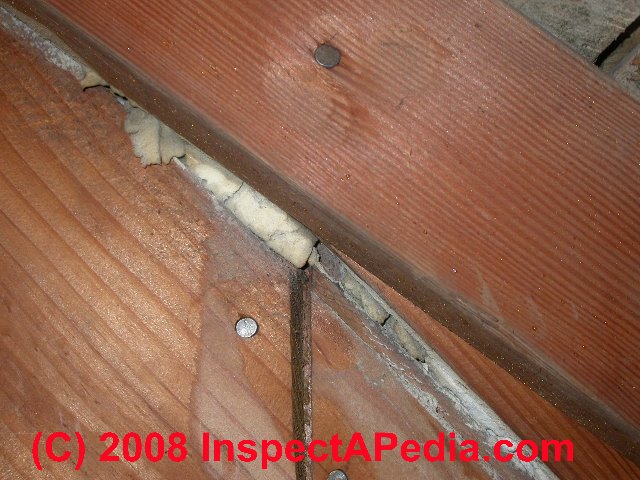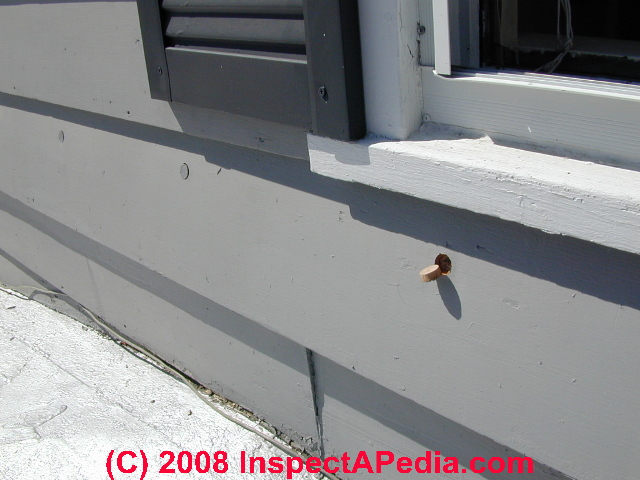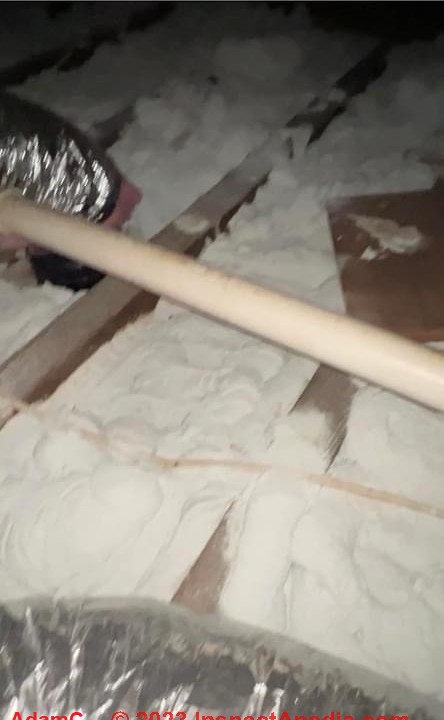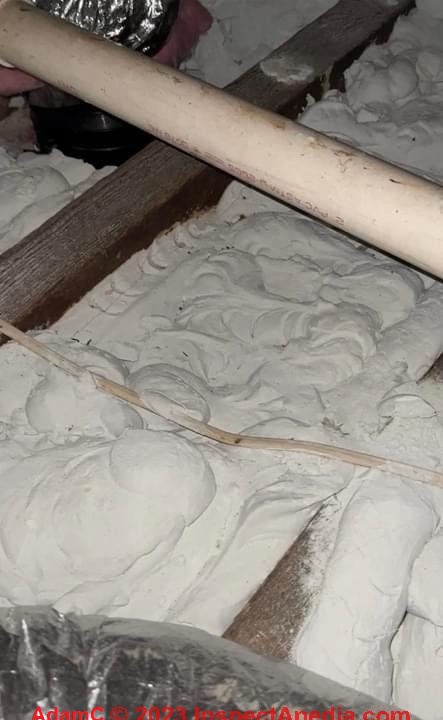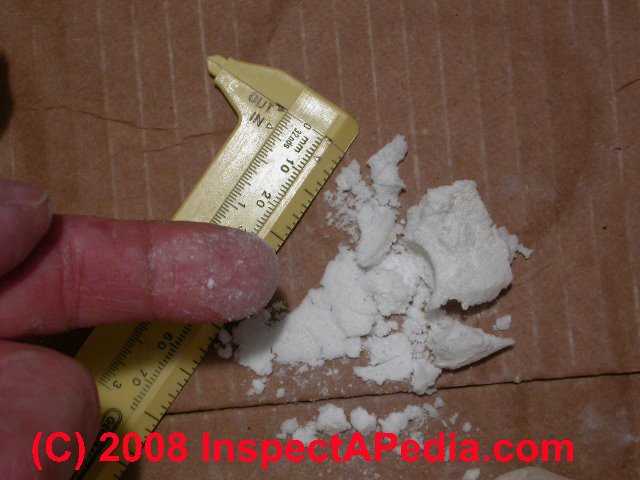 How to Identify UFFI in Buildings
How to Identify UFFI in Buildings
Simple crush test + signs of indoor or outdoor insulation retrofit
- POST a QUESTION or COMMENT about how to recognize or identify the presence of UFFI Urea Formaldehyde Insulation in buildings
UFFI (Urea Formaldehyde Foam Insulation) recognition & identification in buildings.
This article explains simple ways to distinguish UFFI from other types of foam insulation found in buildings.
We also describe visual clues that indicate that an insulation retrofit job has been done at a building from outside or inside.
We include identification photographs and a description of a very simple field test that can immediately distinguish between 1970's vintage sprayed or pumped UFFI insulation and more contemporary icynene or polyurethane spray foam insulation jobs.
This article series on UFFI insulation illustrates and describes UFFI - urea formaldehyde foam building insulation and describes where it is found, when it was used in buildings, how to look for it, how to distinguish this from other building foam insulation products, and its health effects.
InspectAPedia tolerates no conflicts of interest. We have no relationship with advertisers, products, or services discussed at this website.
- Daniel Friedman, Publisher/Editor/Author - See WHO ARE WE?
UFFI Insulation Detetion & Confirmation in Buildings
Article Contents
- HOW TO IDENTIFY UFFI INSULATION - 4 easy DIY methods
- HOW TO SPOT UFFI by INSIDE INSPECTION - where to look, what you'll see
- HOW to SPIT UFFI by OUTDOOR INSPECTION - building clues can indicate blown-in insulation that may be UFFI
4 Ways to Identify UFFI or Urea Formaldehyde Foam Insulation
Our photo shows the dark dusty skin on UFFI insulation (Urea Formaldehyde Foam Insulation) where it oozed from a wall cavity opening into a crawl space in the attic over a building garage.
- Consider the building age
UFFI is not likely to be found in buildings built after the 1970's; insulation retrofit or add-on projects are more likely to be found in buildings which were built with little or no original insulation, such as homes built before 1960. It is unlikely that you'll find UFFI foam insulation in a building built after the late 1970's. - Look for Oozing-out Foam Insulation:
in the attic, basement or crawl space, foamed insulation installation often produces an oozing-out insulation leak at the building sills; in the attic you may find the same oozing insulation shown at the top of gable end walls - as seen in our photograph above. - Look at the foam insulation color and finish skin:
UFFI foam is yellowish and not shiny, but may have picked up dirt or dust during installation as it oozed out of a dirty building cavity or due to simple age and exposure its exterior may be darker yellow. The dried surface may have a very light "skin" that will be dull, not shiny.
Occasionally UFFI may be lighter in color, depending on the environment where it was installed. - Probe the foam insulation - the squash versus crumble test:
a finger tip is fine or if you can only see foam insulation in a tiny wall gap or knothole, try probing with a pencil or even a wire or paper clip: UFFI, urea formaldehyde foam insulation is very soft and crumbly.
At the article linked-to just below we explain this unambiguous way to distinguish among UFFI foam insulation, Icynene® spray foam insulation, and latex foam insulation
If you are having trouble determining what type of foam insulation product has been installed in a building,
see FOAM SPRAY INSULATION TYPES for more detail on the identification of these products in the field.
There you will see more examples of the foam insulation press and crush test that our photos illustrate just below.
If the insulation is UFFI, it easily crushes to a fine powder - (below).
How to Find & Identify UFFI Insulation in an Older Home by Visual Indoor Inspections: Insulation Retrofit Projects
Below we give specific inspection methods useful in building interiors and exteriors that will help spot the types of insulation that may have been added to a building over its life.
Look at interior or exterior building walls for evidence of openings that were cut or drilled to blow-in building insulation.
Since the same type of round openings are used for blowing in cellulose or at least two different types of foam building insulation, if you see these marks or round hole cuts you will need to investigate further to identify the specific type of insulation that was installed.
Our photo above shows interior drill holes in an attic stairwell where insulation was pumped into the building wall cavities. Why so many holes? The first cuts probably hit wood framing.
Photos of typical holes found in a building exterior where insulation was blown or pumped into the wall cavities are provided in detail below
at
How to Spot UFFI Building Insulation in an Older Home by Visual OUTDOOR INSPECTION
Look in basements and crawl spaces for evidence of UFFI (crumbly) foam exuding out into the basement or crawl space at the bottom of wall cavities.
Often there were gaps that permitted this foam escape - usually it was just left in place.
Where balloon framing techniques were used, depending on the adequacy of fire blocking in wall cavities, foam injected into the walls may have passed between floor levels and easily into an attic (as shown in our PHOTO above) or into the basement or crawl space as shown below in the left hand photo.
Look in un-finished areas such as attics and closets
where plaster and lath are left incomplete or where drywall has been omitted during a building retrofit.
Our photos below show UFFI insulation pushing on a poly plastic vapor barrier. Someone has cut the poly in the left photo, perhaps to sample the material - a step that was unnecessary if the inspector simply looked down at his or her feet (photo below-right).

You may also be able to see UFFI or other types of foam insulation oozing out from large openings at the sill plate between floors (photo below-left) or UFFI foam may have oozed out of even small wall openings as we show in the right hand photo of an un-finished plaster lath wall (below right).
Look for small amounts of soft crumbly foam insulation at tiny openings
in wall cavities such as at knot-holes or gaps between siding boards, as we show on our photo (left).
You may need to probe this material to evaluate its density and fragility. If the material easily crumbles to a powder, it is probably Urea Formaldehyde Foam Insulation or UFFI Foam.
Look for scalloped drywall on the inside surface of building exterior walls:
often the UFFI foam insulation was sprayed with more water content than specified; because the insulating material could be quite wet when first installed, we found that in some old homes which had been renovated by replacing original plaster with drywall, the drywall became wet, bonded to the UFFI, and then actually became sunken or concave along the building exterior walls as the UFFI insulation cured.
We pose that the drywall had become soft while wet, that it bonded to the UFFI in the wall cavity, and that as the UFFI insulation dried and cured it also shrank, pulling the damp drywall sections inwards.
We first spotted this phenomenon in an 1890 home in Wappingers Falls, NY when the home was insulated with UFFI spray in the 1970's.
Looking along the top edge of the baseboard trim at the bottom of the wall we saw that the drywall was in contact with the trim only at the location of the wall studs, and that between each pair of studs the drywall was concave.
How to Spot UFFI Building Insulation in an Older Home by Visual Outdoor Inspections: Insulation Retrofit Through Siding
As our pumped-in UFFI insulation retrofit job photos show, plugs may be visible in siding boards, but we warn that they also may have been covered by replacement boards or by a new layer of exterior siding.
Also this plug and pump method for blowing insulation into building walls was used for more types of insulation than just UFFI.
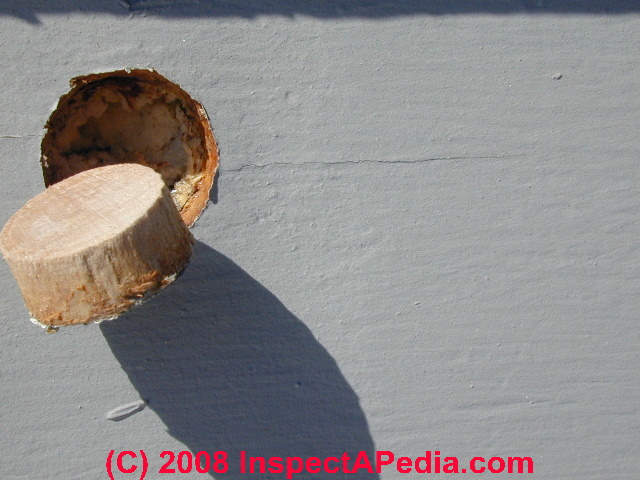
- Look for plugs in the building exterior siding,
pull a plug to examine the insulation material.
As our photographs show above, you may find evidence of circular wall plugs cut into building exterior siding at regular intervals (one opening per stud bay) at one or more elevations on the building.
Pulling one of these wall -cut plugs will give an opening to the building wall cavity where you may find UFFI urea formaldehyde foam insulation (white crumbly foam) or
perhaps BLOWN IN CELLULOSE insulation instead. So don't assume the wall plug means the insulation was UFFI. - Sometimes insulation blow-in holes in walls were covered
not with solid materials but with vented or metal plugs, probably just because they were convenient to snap into the hole cut by a hole saw using the same diameter hole cutting blade.
Insulation may also have been blown into building walls by removing and replacing an entire siding board outside, by lifting and replacing aluminum or vinyl exterior siding installed over original walls of another material, or by openings cut into plaster or drywall in the building interior. \
Watch out: So absence of wall plugs is not absence of blown-in insulation.
...
Reader Comments, Questions & Answers About The Article Above
Below you will find questions and answers previously posted on this page at its page bottom reader comment box.
Reader Q&A - also see RECOMMENDED ARTICLES & FAQs
Have you ever seen this insulation? Crumbly white foam - looks like UFFI
I’ve searched all over and posted on many forums. Nobody can seem to identifying this insulation. It looks hard but it’s soft like sand/flour when touched. It crumbles with easy.
I’ve heard it may be DE, perlite, walite , UFFi insulation and more.
Older home but it was updated at some point.
I am a NYS asbestos inspector and the owner wanted it tested for asbestos. Do you have any idea what type Of insulation this is? - Anonymous by private email 2023-09-05:
Thank you to Adam Clark, a New York home inspector, for these photos and the UFFI Discussion - Ed.
- Contact: Adam Clark - Shield Guard Home Inspections LLC, New York State Capital District & Hudson Valley, Tel: 518-649-9111 Email: ShieldguardInspections@gmail.com Website: ShieldGuardInspections.com
Reply by (mod) - looks like UFFI though whiter than usual; UFFI crumbles-to-powder - try that
Bottom line: What you were describing sounds like and looks like UFFI. It would be very helpful to know more about the building such as the building's actual age and when you think the insulation was installed.
- DE Insulation? Thanks for that one - it's not a product I've heard about. Please tell me what "DE Insulation" refers to and we'll be glad to research it further. Thanks. Daniel.
- Perlite? It's not PERLITE INSULATION (see that page).
- Walite? There is no insulation product I've found called "walite" (your text) but you may have been referring to WALLTITE® Spray Foam Insulation, a BASF product. Walltite is a trademarked name for BASF's spray polyurethane foam insjulation or SPF.
BASF offers both WALLTITE® - a closed cell polyurethane and ENERTITE® - an open celledpolyurethane spray foam insulation.
Here are the BASF SPF TECHNICAL DATA SHEETS - use your browser's BACK button to return to InspectApedia.com.
See details at POLYURETHANE FOAM SPRAY (SPF) INSULATION - if yours is SPF and you squash it, it'll spring back to close to its original form. - UFFI? In contrast, UFFI will crumble - that's one of the easiest, quickest, most reliable and trivial tests I know - described and illustrated above on this page.
Can you post a photo of the crumbled material? While other, newer foam insulating products vary from hard to soft, I've not found versions other than UFFI that crumble to a grainy powder simply with the use of a hand or fingers.
It does not look to me like
PERLITE INSULATIONI am not familiar with "walite" insulation, though perhaps you meant "WALLTITE" a modern closed cell polyurethane spray foam (SPF) insulating brand produced by BASF. I have not found a polhurethane spray foam insulation that was "crumbly."
Please elaborate or expand "DE" insulation - I'm not sure what you're referring to.
Did you search our website and read our descriptive information
about UREA FORMALDEHYDE FOAM INSULATION, UFFI ?
I also recommend scanning
OPINION: I can't imagine any reason to test that spray foam insulation for asbestos.
I don't think we'll find a research source that cites deliberate combination of asbestos material with foam insulation. If you have come across that's your reference I sure would like to know about it.
However I have found older homes where spray foam as well as other products were applied over older asbestos insulation such as around pipes - as an insulating encapsulant.
Bottom line: UFFI - Urea Formaldehyde Foam Insulation - not an asbestos product.
I look forward to hearing more from you on this and to seeing photos of the crumbled insulation. - Daniel
Reader follow-up: This is UFFI Insulation
I've come to the Conclusion it is UFFI insulation. Looks like it broke down over the years. Thank you for always responding to my emails . I love your website.
Moderator reply
I agree with your conclusion - after we started discussing this I looked back though my photos and notes including some of the photos above on this page and confirnmed that indeed some of the UFFI I've found in buildings was dead white while other was quite yellow - sometimes side by side.
Reader follow-up: This is UFFI Insulation - test confirmed no asbestos
Up close the insulation has a light gray tint to it that you can't see in the picture. The text resembles wet sand and crumbles in your hand when you apply limited pressure. As it crumbles it feels like sand/flower.
The flash on the camera makes it look a little more white than it is. The contractor wanted it tested for asbestos so we did. Results were 100% non fibrous.
...
Continue reading at UFFI SHRINKAGE, THERMAL BYPASS LEAKS or select a topic from the closely-related articles below, or see the complete ARTICLE INDEX.
Or see these
Recommended Articles
- FOAM SPRAY INSULATION TYPES - an identification guide to spray foam insulating products
- FORMALDEHYDE GAS HAZARD REDUCTION for other measures to reduce indoor formaldehyde levels
- INSULATION IDENTIFICATION GUIDE - home
- UREA FORMALDEHYDE FOAM INSULATION, UFFI - home
- URETHANE FOAM DETERIORATION & OUTGASSING
Suggested citation for this web page
UFFI, HOW TO IDENTIFY in BUILDINGS at InspectApedia.com - online encyclopedia of building & environmental inspection, testing, diagnosis, repair, & problem prevention advice.
Or see this
INDEX to RELATED ARTICLES: ARTICLE INDEX to BUILDING INSULATION
Or use the SEARCH BOX found below to Ask a Question or Search InspectApedia
Ask a Question or Search InspectApedia
Questions & answers or comments about how to recognize UFFI Urea Formaldehyde Insulation in buildings.
Try the search box just below, or if you prefer, post a question or comment in the Comments box below and we will respond promptly.
Search the InspectApedia website
Note: appearance of your Comment below may be delayed: if your comment contains an image, photograph, web link, or text that looks to the software as if it might be a web link, your posting will appear after it has been approved by a moderator. Apologies for the delay.
Only one image can be added per comment but you can post as many comments, and therefore images, as you like.
You will not receive a notification when a response to your question has been posted.
Please bookmark this page to make it easy for you to check back for our response.
IF above you see "Comment Form is loading comments..." then COMMENT BOX - countable.ca / bawkbox.com IS NOT WORKING.
In any case you are welcome to send an email directly to us at InspectApedia.com at editor@inspectApedia.com
We'll reply to you directly. Please help us help you by noting, in your email, the URL of the InspectApedia page where you wanted to comment.
Citations & References
In addition to any citations in the article above, a full list is available on request.
- 3/07: thanks to Gary Randolph, Ounce of Prevention Home Inspection, LLC Buffalo, NY, for attentive reading and editing suggestions. Mr. Randolph can be reached in Buffalo, NY, at (716) 636-3865 or email: gary@ouncehome.com
- Thanks to reader Anna Marron for discussion of UFFI-insulated building retrofit options 05/29/2010
- In addition to citations & references found in this article, see the research citations given at the end of the related articles found at our suggested
CONTINUE READING or RECOMMENDED ARTICLES.
- Carson, Dunlop & Associates Ltd., 120 Carlton Street Suite 407, Toronto ON M5A 4K2. Tel: (416) 964-9415 1-800-268-7070 Email: info@carsondunlop.com. Alan Carson is a past president of ASHI, the American Society of Home Inspectors.
Thanks to Alan Carson and Bob Dunlop, for permission for InspectAPedia to use text excerpts from The HOME REFERENCE BOOK - the Encyclopedia of Homes and to use illustrations from The ILLUSTRATED HOME .
Carson Dunlop Associates provides extensive home inspection education and report writing material. In gratitude we provide links to tsome Carson Dunlop Associates products and services.







